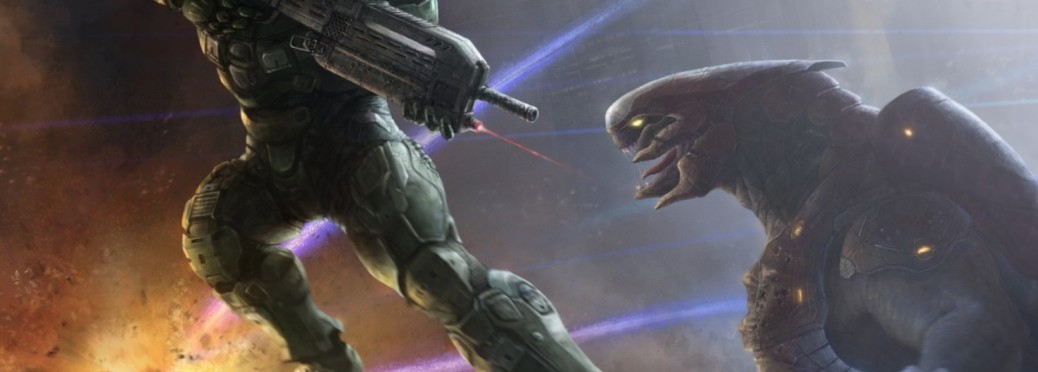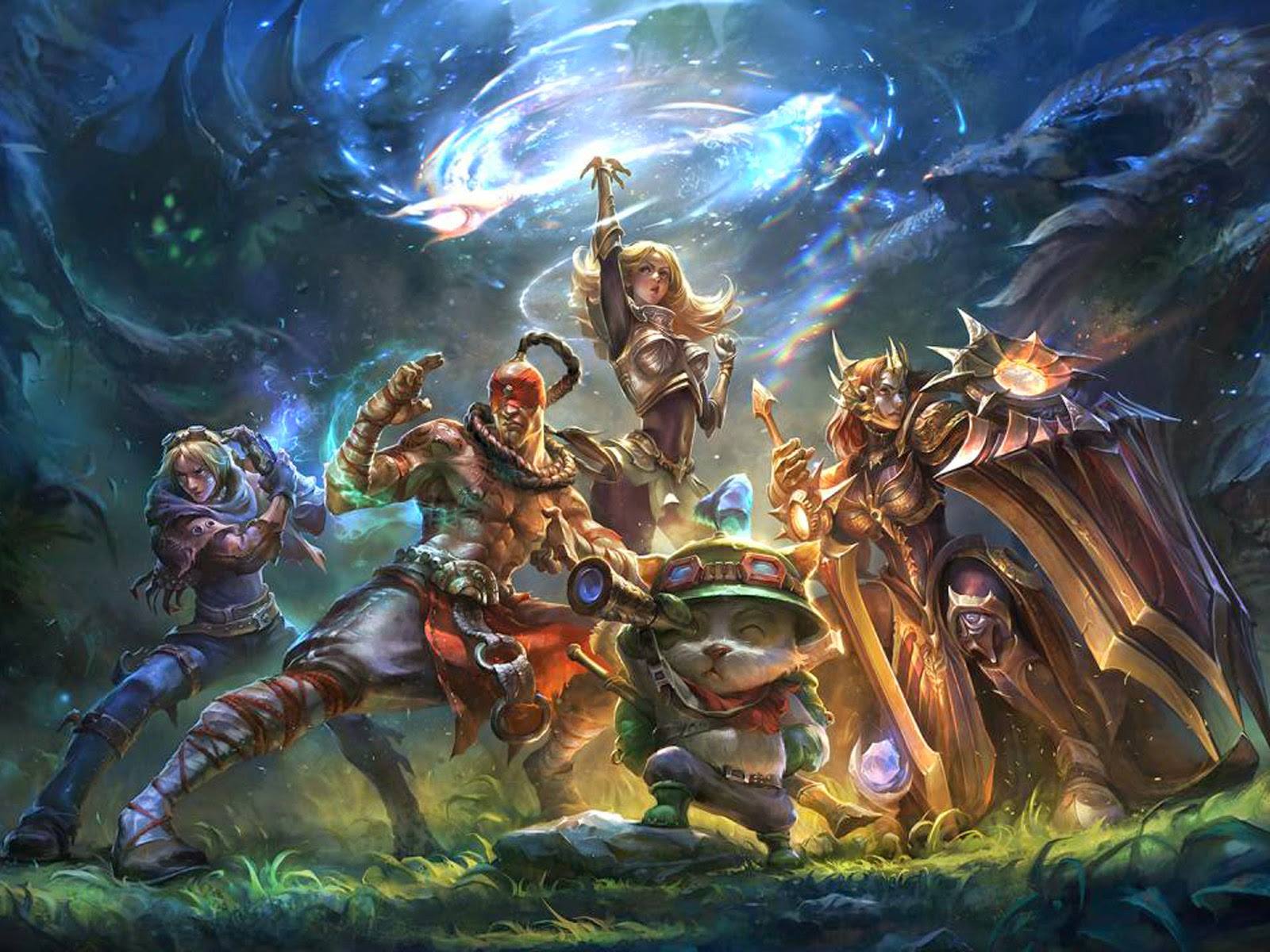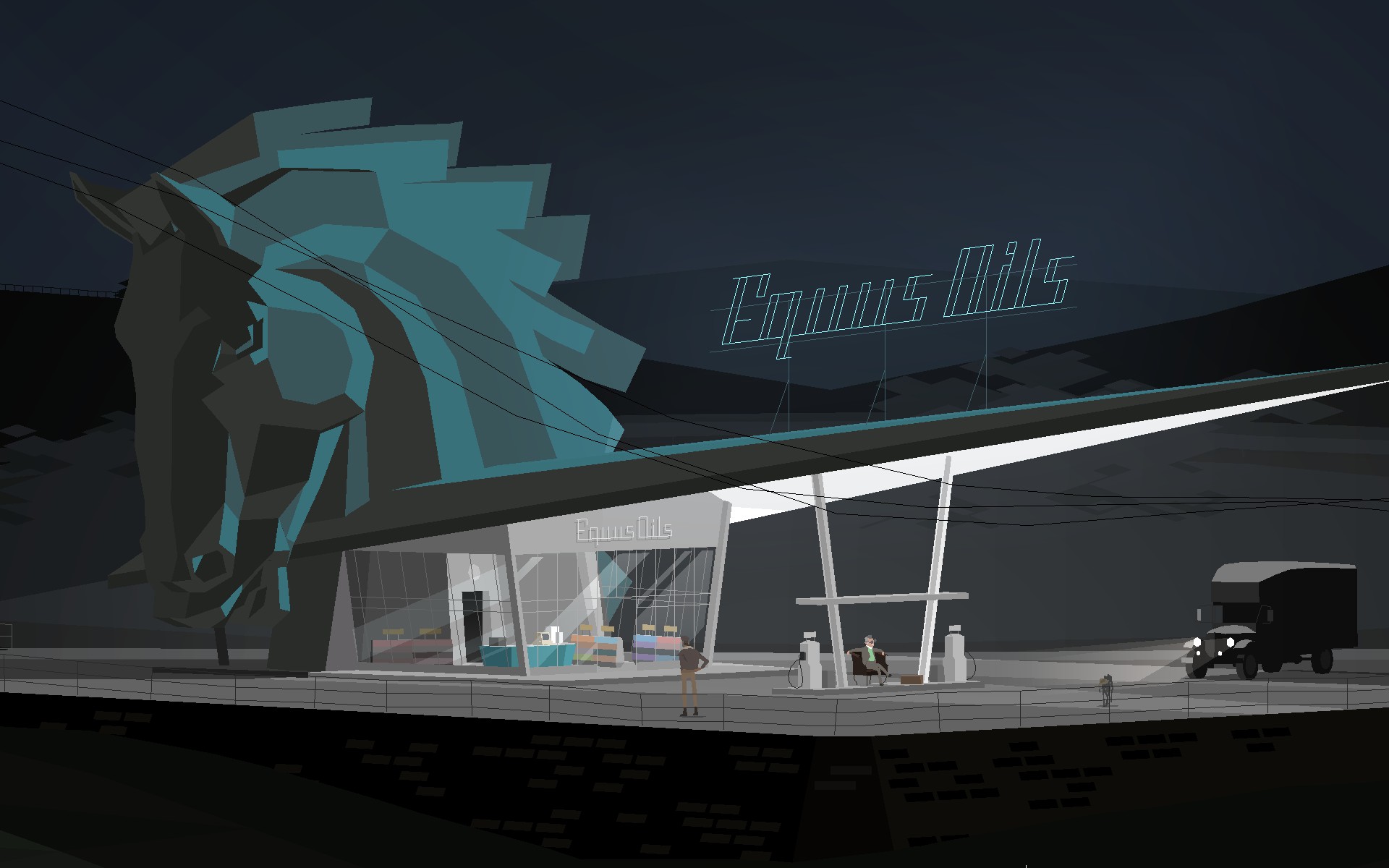Like the War on Terror, Halo2 is about protecting home and holding on to Christian ideals in the face of alien invaders.
By Amanda Barwick
Religion and violence—two concepts that seem to be at different ends of the moral spectrum. Growing up, I was a happy, uncomplaining churchgoer. But also, starting at the age of eight (practically nine), I began enthusiastically playingBungie’s new release, Halo: Combat Evolved and its sequels of the subsequent decade. These two activities, attending church and regularly playing violent videogames, would seemingly produce two completely different people, one righteous and one violent, but I’ve found that, strangely, they complement each other. An analysis of history would encourage this complement between religion and violence, as almost every human conflict over the course of history has been in the name of one or more parties’ religious beliefs.
Halo: Combat Evolved was released on November 15, 2001, almost exactly two months after the 9/11 attacks in New York. Halo 2, released November 9, 2004, was conceptualized, created, and released entirely in a post-9/11 environment of heightened military activity, intensified patriotism, and increased awareness and persecution of Middle Eastern religions such as Islam. Pres. George W. Bush’s address after the attacks in New York and Washington D.C. set the tone for the attitude toward this religiously motivated attack and how America—a deeply Christian and religious country itself—would respond: “America was targeted for attack because we’re the brightest beacon for freedom and opportunity in the world. And no one will keep that light from shining…. America and our friends and allies join with all those who want peace and security in the world and we stand together to win the war against terrorism.” It was made clear from the beginning that this war would be one of ideals and values, not one of economy or even politics (though clearly these played a role as well). Halo 2 reflects the American values of exceptionalism, heroism, and Christianity that were intensified during the post-9/11 period and even though it is highly militaristic, pits religious values against religious values. Like the War on Terror, Halo2 is about protecting home and holding on to Christian ideals in the face of alien invaders.
As a young person, 11 or 12 years old, my interpretation of these games were simplistic and largely emotion-based. I readily soaked up the patriotic songs, assemblies, and speakers we had at my school following the 9/11 attacks and was swept away in the concussive heroism and plain awesomeness of the Halo game. I never remember feeling that this heroic violence violated any of my religious beliefs. I viewed its violence much like how I saw the violence in the Lord of the Rings films and even in the Book of Mormon. The game’s plot, design, and music all encourage the image of righteous violence with their overt and covert themes of American Christianity and foreign Islam.
However, it is too simplistic to say that Halo 2 is a recreation of America versus Iraq or Pakistan—the plot takes a much more complex approach that further supports the idea that religion and violence are co-motivated and affecting. In order to understand the complexities, a quick overview of the game’s backstory is required. The Master Chief is the last of a class of soldiers called Spartans—genetically and surgically altered super-soldiers conditioned for intense combat and cool decision making. They wear high-tech armor that enhances their strength and also provides a close fitting energy shield for additional protection. The Covenant is the theocratic-militaristic coalition of aliens led by three Prophets—Regret, Truth, and Mercy. The dominant species of alien in the Covenant are the Elites, upright aliens with mandible-like mouths. Other species include Grunts, Hunters, and Brutes, all of which were conquered and assimilated into the Covenant. Another species, the Flood, are parasitic creatures that kill their hosts and animate their bodies;, their sole purpose being to consume all life.
The Halo, which gives the game its namesake, is a ring-like structure designed by ancient Forerunners as a weapon to destroy all sentient life in case the Flood couldn’t be stopped. So while the Covenant is humanity’s enemy, the Flood threaten both humans and aliens.
Halo 2 is unique from other first-person shooters in that you play half the game as the so-called enemy. In the opening scene, we see Sergeant Johnson and Master Chief receiving medals for their victory in destroying the Halo (the aforementioned ring-like structure designed by ancient Forerunners to wipe life from the galaxy) from the previous game. This award ceremony is crosscut between a tribunal for Thel ‘Vadamee, the Elite officer in charge of hunting down the Master Chief in the previous game. Here, he is stripped of his armor and rank and is branded with an iron as a coward and heretic. Other aliens jeer at him and call for his death as he is dragged to the branding block. The juxtaposition of the Chief’s glory and Thel ‘Vadamee’s failure is stark, building sympathy for the disgraced Elite and even a little guilt at having won the previous game and sent him to this fate. Crosscutting between the two different ceremonies emphasizes that war produces both a victor and a loser, both of which have strong ideological motivations and consequences for engaging in war. After the tribunal, Thel ‘Vadamee is dragged to a meeting with the Prophets, who want control of the rings because they believe they are sacred and that activating them will begin their Great Journey to salvation. Here he becomes their Arbiter, a sacrificial soldier and tool for the Prophets, in order to redeem himself and to die an honorable death.
At first, playing as the Arbiter was confusing, because previously I had been conditioned to blindly shoot anything that wasn’t human. But in the first level playing as the Arbiter, you quickly learn to distinguish your ally aliens from the heretic aliens you are sent to silence by order of the Prophets. The only distinction between them is a change of armor. This design of the game emphasizes its procedural rhetoric—that enemies aren’t determined by race but by the ideals they believe in. Repeatedly playing through these procedures encourages judgment not based solely on appearance, but on religious and ideological affiliation. Critic Gerald Voorhees states that “by alternatingly positioning the player as characters on opposite sides of the game’s central conflict, H2 [Halo 2]encourages players to accept, reject or entertain ambivalence about America’s War on Terror.” The Covenant also gain voices in this game, a huge departure from the animalistic grunts, yells, and garbled English from the first game, additionally encouraging sympathy for foreign plights and beliefs. The incorporation of religion into the Covenant’s motivation and its complex relationship with the humans in the game—alternating between enemy, ally, and friend—tie the game’s plot back to the real-world circumstances of terrorism and the battle of beliefs between America and her enemies.
Eventually Master Chief and the Arbiter are both captured by the Gravemind, the hive-mind center of the Flood on that ring, who reveals the ring’s true destructive purpose to the Arbiter. The Gravemind examines the two characters, first the Chief, then the Arbiter, stating, “This one is machine and nerve and has its mind concluded. This one is but flesh and faith and is the more deluded.” His analysis of the two enemies reveals that both are “operating on black-and-white assumptions that are untenable in a complex world” (Annandale). He then sends Master Chief and the Arbiter to different locations to stop the Covenant from activating the ring, as it is in all their interests not to die. However, Master Chief soon discovers that he was sent as merely a distraction so the Gravemind could send the Flood to infest human ships and spread the infection. With this twist in the narrative, the Flood become the humans’ and the Elites’ common enemy, as an even greater threat than the Covenant. By presenting the Master Chief and the Arbiter as equal heroes both guided by sympathetic beliefs, “Halo 2 questions not a specific ideology, but ideological dogmatism of any stripe” (Annandale). Their conflict is then made into a clash of ideologies, not politics or economics.
By way of establishing the metaphor of the Covenant with extreme Islamic beliefs, the cutscene before the first level playing as the Arbiter shows the Elites chanting ritualistically after leaving the Covenant Holy City to hunt down a heretic leader:
Elite Leader: When we joined the Covenant, we took an oath…
Elite soldiers: …according to our station. All without exception.
Elite Leader: On the blood of our fathers, on the blood of our sons we swore to uphold
the Covenant…
Elite soldiers: …even to our dying breath!
Elite Leader: Those who would break this oath are heretics, worthy of neither pity nor
mercy. Even now, they use our Lord’s creations to broadcast their lies.
Elite soldiers: We shall grind them into dust!
Elite leader: And continue our march to glorious salvation!
In the year 2001, I was shocked twice by the idea that violence could be carried out in the name of religion, in the name of God—once by the terrorists of 9/11, and once by the introduction of the Covenant enemy in the first Halo. However, I now realize that both sides, both in the real and virtual worlds, fought in the name of religion, both covertly as part of their culture and overtly. The United States and the humans in Halo 2 also get caught up in religious fervor of a different kind—hero worship and stubborn elitism.
To further explore the metaphor of humans being Christian Americans, let’s look at Master Chief’s design as an avatar character. Though he has more character than he did in Halo: Combat Evolved, Master Chief is still the strong, silent (except for the macho one-liners) American hero. He embodies American exceptionalism in several different ways: he is the only surviving member of the Spartans, a class of super-soldiers that never die, merely go missing in action; he is a special weapon kept in cryo-sleep until the cause is dire enough; his armor is unique because he is the only one strong enough to wear it; and he is given special permissions by the United Nations Space Command (UNSC) to engage in risky missions. One of the many examples of the Master Chief’s exceptionalism is in the cutscene just after the first level “Return to Sender” when a gigantic bomb the Covenant planted on the ship has been secured and deactivated seconds before detonation. Captain Keyes of a fellow cruiser asks Lord Hood of the UNSC for permission to attack, and Cortana, an AI and the Chief’s companion, comments:
Keyes: Pyro, this is In Amber Clad, the carrier’s shield is down. I’m in position and ready
for immediate assault.
Lord Hood: Negative, Commander. Not against a ship that size. Not on your own.
Master Chief: Sir, permission to leave the station.
Lord Hood: For what purpose, Master Chief?
Master Chief: To give the Covenant back their bomb.
Lord Hood: [pause] Permission granted.
Cortana: I know what you’re thinking, and it’s crazy.
Master Chief: So? Stay here.
Cortana: Unfortunately for us both, I like crazy.
Master Chief then drags the bomb to an airlock which he plans to open, launching himself and the bomb toward the Covenant carrier and detonating the bomb. Just before he opens the bay door, Cortana asks, “Just one question. What if you miss?” to which Master Chief replies, “I won’t.” Flying through crossfire and explosions, he delivers it to the carrier’s core, activates the detonator, and rides the explosion back to his cruiser, all without the aid of a jet pack or rockets. If this isn’t an example of the guns-out, heroic action, exceptionalist American attitude, I don’t know what is. Christianity ties into this attitude as well, as it values one man’s ability and sacrifice to save all others. While circumstances make the Arbiter special, the Master Chief is innately talented, born special to be viable for the Spartan program and unique in being the only one to survive. The Master Chief is a Christ-type that plays into American values of individualism and sacrifice for a worthy cause.
In fact, all the humans prove to be unique, as they are the only ones able to activate the ring. As descendants of the Forerunners (the ancient race that built the rings as a last resort against the spread of the Flood), humans are the ones destined to activate the rings because their genetics trigger the device, even though the Covenant are the ones who see the rings as sacred. The design of the game, though it creates sympathy for the Covenant (especially the Elites), places the heroism on humans and their very existence. Voorhees also comments that “just as official discourses of the War on Terror produce the belief that the conflict is winnable by drawing from the ideological mélange of American exceptionalism and Christian fundamentalism, H2 assures players that the game is winnable by positioning them as one of only two remarkable characters uniquely capable of addressing the woes that assail the galaxy.” Even though the feat of saving the galaxy (or ridding the world of terrorism) seems impossible, you never doubt Master Chief’s (or America’s) ability to make it happen because of his unwavering self-confidence and capability. Players are encouraged to envision themselves as the Master Chief because his face is never revealed, creating a void of anonymity for the player to fill.
As a young player, I never doubted that I could achieve the goals of the game and save all sentient life in the galaxy, just as I never doubted that the U.S. government and armed forces could eradicate terrorism and bring those responsible for the 9/11 attacks to justice. Admittedly, a game is designed to be winnable, but as a kid I had played my fair share of unwinnable levels and bosses. But being Master Chief with all his confidence, capability, and macho one-liners, I had more confidence in myself. In an interview with IGN, game designer Jason Jones explains how “every player-facing verb needs to be a power fantasy in some way” (McCaffrey). In a culture that hero-worships soldiers, especially now that such a moral, religious cause was being fought for, I transferred my admiration for the military onto Master Chief, the ultimate soldier. In fact, until about 8th grade, I seriously considered joining the military. The lure of being a hero and fighting actively for a good cause and a great country, combined with being virtually immersed in the heightened military environment of Halo 2and the patriotic atmosphere of my public schools, made joining the military (wisely only mentioned once to my mother) my secret daydream.
Another large part of the game experience for me has always been the score of Halo 2. The musical themes in the Halo games have always been a huge marketing and gameplay staple and also play a prominent role in blending the religion and violence of the story together. The main theme of the game uses a Gregorian chant, invoking an ancient, ritualistic atmosphere to the alien technology and races encountered in the game. Strong drums are also used throughout, meant to represent drums of war and to color the Covenant as a tribal people and to emphasize the native history of America for Master Chief. The more religious, hymn-like music is always used when Halo or the Covenant are present, and the electric guitar motif is used mainly for the Master Chief. The electric guitar segments hearken back to the rock religiously listened to during the Vietnam War through the 1960’s, as rock music itself could be considered a cult or religion because it dictates a certain lifestyle and attitude of life. Americans strongly identify with rock and roll and its we-don’t-care, powerhouse attitude. The addition of the electric guitar riffs was new for Halo 2 and keeps with the strong American identification that Master Chief and humanity have in the game.
Halo 2 was conceptualized, designed, created, and released in a post-9/11 culture rich in patriotism, xenophobia, and military hero-worship. America dusted off its traditional Christian values and the War on Terrorism, and subsequently the plot of Halo 2, was a conflict of good and evil, decentralized and centralized religion, and ideology. However, while the game strongly identifies with America’s stance at the time, it also encourages sympathy for the Covenant, a race ruled and motivated by other causes. It isn’t simply a recreation of the American-Iraqi or any other Middle Eastern conflict—its complex plot, design, and characters encourage players to consider both sides of the conflict and to unite against a greater enemy, complete annihilation. Religion and violence go hand in hand in Halo 2, supported by the faith-driven military coalition of the Covenant and the Christian exceptionalism of Master Chief, as well as the contrasting yet complementary hymn-like and rock themed score. My own experience playing the game, especially when it first came out and I was a young churchgoer, strongly identifies with the ideological conflict in the game and its subsequent argument that religion demands to be fought for.
Works Cited
Annandale, David. “Avatars of Destruction: Cheerleading and Deconstructing the ‘War on
Terror’ in Video Games.” Reframing 9/11: Film, Popular Culture and the “War on Terror.” New York: Bloomsbury, 2010. 97–106. Print.
Halo 2. Bungie Studios. 9 Nov. 2004.
McCaffrey, Ryan. “Halo and Destiny Creator Breaks 11-year Silence, Talks Design Philosophy.”
IGN. Web. 2 Nov. 2014.
“Text of Bush’s address” CNN 11 Sept. 2001. Web. 9 Oct. 2014.
Voorhees, Gerald. “Play and Possibility in the Rhetoric of the War on Terror: The Structure of
Agency in Halo 2.” Game Studies 14.1 (2014). Web. 9 Oct. 2014.



